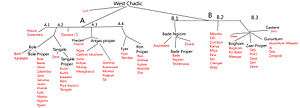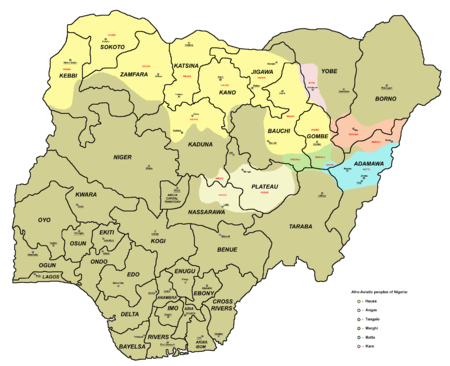Bade languages
The Bade languages (also known as B.1 West Chadic or the Bade–Ngizim languages) are a branch of West Chadic languages that are spoken in Borno State and Jigawa State of northern Nigeria. Bade is the most widely spoken language with 250,000 speakers, followed by Ngizim with 80,000 speakers.
| Bade | |
|---|---|
| B.1 West Chadic | |
| Geographic distribution | Borno State and Jigawa State, Nigeria |
| Linguistic classification | Afro-Asiatic |
| Glottolog | west2710[1] |
 West Chadic per Newman (1977) | |

Main Chadic-speaking peoples in Nigeria
Names and locations
Below is a comprehensive list of Bade language names, populations, and locations from Blench (2019).[3]
| Language | Cluster | Dialects | Alternate spellings | Own name for language | Endonym(s) | Other names (based on location) | Other names for language | Exonym(s) | Speakers | Location(s) |
|---|---|---|---|---|---|---|---|---|---|---|
| Auyokawa (extinct) | Jigawa State, Kafin Hausa LGA, Auyo | |||||||||
| Shira (extinct) | Shirawa | Shira town, Jigawa State, Kafin Hausa LGA; extinct | ||||||||
| Teshena (extinct) | Teshenawa | Teshena town, Jigawa State, Kafin Hausa LGA; extinct | ||||||||
| Bade | Western Bade (Magwaram, Maagwaram), Southern Bade (Bade k-Aɗo), Gashua Bade (Mazgarwa) | Bedde | Gidgid | 31,933 (1952 W&B) includes Duwai and Ngizim; 100,000 (1973 SIL) | Borno State, Bade LGA; Jigawa State, Hadejia LGA | |||||
| Ɗuwai | Duwai | Lvji | Eastern Bade | Borno State, Bade LGA | ||||||
| Ngizim | Ngezzim | 39,200 includes Bade and Ɗuwai (1952 W&B); 25,000 Schuh (1972) | Borno State, Damaturu LGA |
gollark: I tried a random bytecode disassembler from the interwebs, but I doubt any work with LuaJ.
gollark: I'm trying to very slowly bruteforce it now.
gollark: Lua strings are just byte arrays basically, if that's what you mean.
gollark: Because.
gollark: So hexadecimal?
References
- Hammarström, Harald; Forkel, Robert; Haspelmath, Martin, eds. (2017). "West Chadic B.1". Glottolog 3.0. Jena, Germany: Max Planck Institute for the Science of Human History.
- Blench, Roger. 2006. The Afro-Asiatic Languages: Classification and Reference List (ms)
- Blench, Roger (2019). An Atlas of Nigerian Languages (4th ed.). Cambridge: Kay Williamson Educational Foundation.
External links
This article is issued from Wikipedia. The text is licensed under Creative Commons - Attribution - Sharealike. Additional terms may apply for the media files.